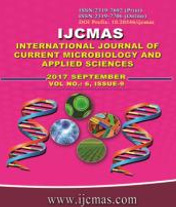


 National Academy of Agricultural Sciences (NAAS)
National Academy of Agricultural Sciences (NAAS)

|
PRINT ISSN : 2319-7692
Online ISSN : 2319-7706 Issues : 12 per year Publisher : Excellent Publishers Email : editorijcmas@gmail.com / submit@ijcmas.com Editor-in-chief: Dr.M.Prakash Index Copernicus ICV 2018: 95.39 NAAS RATING 2020: 5.38 |
Kilakarsal sheep population variability and structure was investigated genetically utilizing FAO recommended 25 microsatellite markers. Estimates of genetic variability such as effective number of alleles and gene diversities revealed substantial genetic variation detected by microsatellite markers. A total of 241 alleles were detected and the actual number of observable alleles ranged from five (BM6526) to a maximum of 16 (MAF70). The mean number of alleles (allelic diversity) was 9.64. The effective number of alleles which is lower than the observed number of alleles, was between 2.279 (OarCP20) and 8.510 (MAF70) with a mean of 4.786 alleles. The average observed heterozygosity (Ho) and expected heterozygosity (He) were 0.690 and 0.782 respectively. However, the study evidenced a significant departure from Hardy-Weinberg equilibrium in 13 loci. Such lack seems to be caused by a rather high level of inbreeding (FIS=0.097).
 |
 |
 |
 |
 |